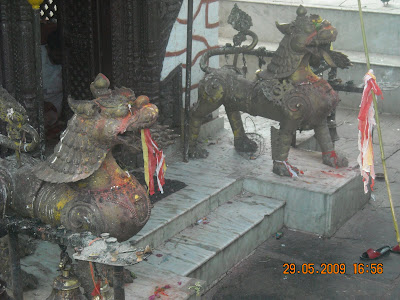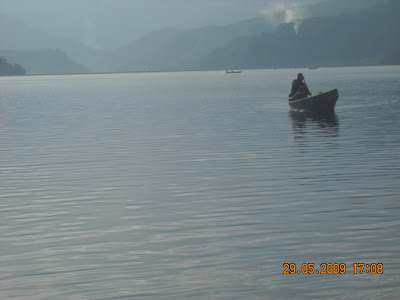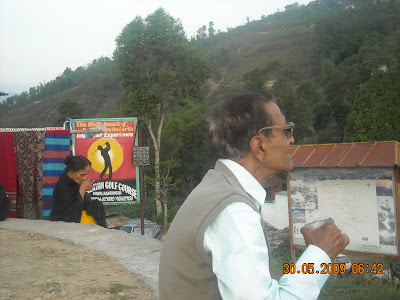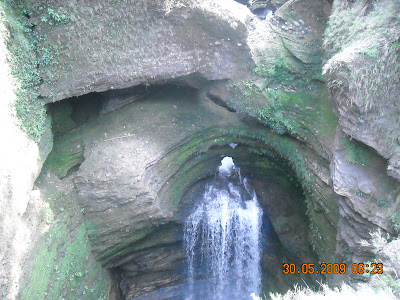Pokhara is a remarkable place of natural beauty. Situated at an altitude of 827m from the sea level and 200km north-west of Kathmandu valley, the city is known as a center of adventure. The enchanting city with a population of around 95,000 has several beautiful lakes and offers stunning panoramic views of Himalayan peaks. The serenity of lakes and the magnificence of the Himalayas rising behind them create an ambiance of peace and magic. So today the city has not only become the starting point for most popular trekking and rafting destinations but also a place to relax and enjoy the beauty of nature.
The beautiful Annapurna Ranges of Pokhara with my Car in the fore-ground, dated 9th Dec'2008.
At Pokhara, the three main Tourist attractions are:-
* Phewa lake;
* Annapurna Ranges;
* Devi's Falls & Gupteshwar Caves.
This Blog contains images of above three places for two different dates - One, of 09.12.08 (with Sumona & Shristi), and another, of 29/30.05.09 (with Mom & Dad). The Annapurna Ranges are clearly visible from October to March months.
(1). The "Phewa" Lake:-
Phewa lake, the second largest lake in the kingdom, roughly measuring 1.5 km by 4 km, is the center of all attractions in Pokhara. The enchanting lake is an idyllic playground. Brightly painted wooden boats and sailboats can be rented on reasonable cost around lakeside.
The lake is neither deep (roughly 47 meters at most) nor particularly clean, but the water is warm and swimming is pleasant if you don't think about the probable pollution.The eastern shoreline of the lake, popularly known as Lakeside or Baidam, consists of seemingly endless strip of lodges, restaurants, bookshops and souvenir shops. One of the fascinating parts of lakeside is the splendid view of the mountains, especially when the still water reflects the peaks, creating a double image.
The entrance to the Lake.

Mom & Dad at Phewa Lake.

Sumona & Shristi, by the side of the Lake, with Annapurna Ranges in the background.

The lake is the home of 17 species of native fish and 4 exotic species. The forest and lake is the habitat of 6 species of amphibians, 14 species of reptiles, 34 species of mammals and 104 species of birds. Out of 104 species of birds, 14 are migratory species.

Boating on this Lake is a major attraction for people of all ages.

Mom & Dad enjoying the boating experience.



Some Indian Tourists also seen.

Some westerners.

A boatman.

The water appears somewhat greenish.

The first main attraction is the pagoda style temple in the lake which is the shrine of Barahi (Water Goddess).



Dad, in full devotion, outside the Barahi temple.

The view from the Temple is simply breath-taking.



One can also see tourists enjoying "Paragliding", from the mountains, across the lake.
A Tourist sporting a strange head-gear.
The Locals enjoying Water-Sports.
Talking about Water-Sports, below are the images of actual sports of water, men enjoy since times immemorial.
Step -(1):-
Step -(2) :-
Step -(3) :-
The serenity of Phewa lake , create an ambiance of peace and magic. I took my time to capture the moods of the nature at the Phewa Lake of Pokhara. Though the Annapurna Ranges were not visible due to clouds and haze, but the Beauty of the Nature was fantastic, which the words simply cannot describe. I leave that job to the Photos I produce below:-





On the shores of the Lake, you find locals selling curios.
Hard-drinks are very common here, as common as Tea-shops in India.
Businessmen are very professional here. In fact, they charge you for even a piss, here.

So, that was "Phewa Lake" of Pokhara.
(2). The Annapurna Ranges from Sarangkot:-
As the days were cloudy here in the month of May'2009, the Annapurna Ranges were simply not visible. Our bad Luck. So, we decided to try our luck in the early morning from a Mountain-top, called "Sarangkot". We woke up at 4 A.M and climbed up the range by 5.50 A.M. Below, is the first image of Mount Annapurna.

At an altitude of 1592 meters, "Sarangkot" sits north of Pokhara overlooking the valley and Phewa Lake. Just a short 2 hour scenic trek through small villages and jungle from the main tourist area of Pokhara, or a 45 minute taxi ride.
Sarangkot is a beautiful village best known for its sunrise, where on a clear day you can see an unobstructed view of the Himalayan mountains of Annapurna rang, Dhauligiri, Fishtail. Another main attraction to Sarangkot is to spend an hour in the sky paragliding with fantastic views of the mountains and the city below.
Tourists, atop Sarangkot, at 6 A.M, having a faint glimpse of Mount Annapurna, which is at a height of 8000+ mts.
Mom & Dad, atop Sarangkot, with Mount Annapurna, in the background.
The Scintillating views of the Morning Sky.






Gupteswar Gupha is a sacred cave, lies 2 km from Pokhara airport on the Siddhartha Highway leading southwest from the city. The entrance is right across from Devi's Fall and the cave is almost 3 km long. It has some big hall-size rooms and some passages where you have to crawl on all fours. This cave holds special value for Hindus since a phallic symbol of Lord Shiva is preserved here in the condition it was discovered.


This Cave is divided into two parts. First parts is about 40 meters long, there is a natural cave and temple of Load Shiva . In this first part you are not allowed to take photos. Next parts start after temple which goes to the down side of Devis fall, the distance about 100 meters from second entrance, from there you can see the view of Davis Fall as well as natural rocks. Electric lights are installed here for the convenience of the visitor. After the Lord Shiva temple (on second part of this Cave) you are allowed to take photos. Second parts is closed during 4 month of Monsoon (June, July, August and September)
All photos produced here, are taken in the second part of the Cave. Dad, in the second part of the cave, below.

The walls of the cave.


Mom & Dad enjoying the morning cuppa of Hot Tea in the chilled atmospheres.
They are really enjoying.
Mom with Me.
Myself lost in the beauty of the Nature.


The Annapurna Range, in full bloom, of course in the month of December. Following are some such Images.
The "Fish-Tail" Mountain, which is considered a sacred mountain, has not been climbed by anyone, due to religious reasons.
(3). Devi's Falls & Gupteshwar Caves :-
Water coming from Phewa lake vanishes into the earth at the Devi's Fall. Locally known as Patale Chhango, Devi's fall is an attractive waterfall lying about 2 km south-west of Pokhara valley. Devi, a Swiss lady, was swept away when the floodgates were accidently opened.


This is a breath taking view of Davis Fall in Chorrepatan. Chorrepatan is famous for this water fall and there is also a cave just two minutes walk from this fall. The water flowing in this fall comes from Fewa lake and the fall is worth visiting during the rainy seasons as it possesses its maximum velocity.
Gupteswar Gupha is a sacred cave, lies 2 km from Pokhara airport on the Siddhartha Highway leading southwest from the city. The entrance is right across from Devi's Fall and the cave is almost 3 km long. It has some big hall-size rooms and some passages where you have to crawl on all fours. This cave holds special value for Hindus since a phallic symbol of Lord Shiva is preserved here in the condition it was discovered.

The caves.

This Cave is divided into two parts. First parts is about 40 meters long, there is a natural cave and temple of Load Shiva . In this first part you are not allowed to take photos. Next parts start after temple which goes to the down side of Devis fall, the distance about 100 meters from second entrance, from there you can see the view of Davis Fall as well as natural rocks. Electric lights are installed here for the convenience of the visitor. After the Lord Shiva temple (on second part of this Cave) you are allowed to take photos. Second parts is closed during 4 month of Monsoon (June, July, August and September)
All photos produced here, are taken in the second part of the Cave. Dad, in the second part of the cave, below.

The walls of the cave.
















































No comments:
Post a Comment